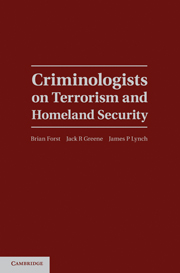Book contents
- Frontmatter
- Contents
- About the Authors
- Preface
- 1 Introduction and Overview
- PART I NATURE OF THE PROBLEM
- PART II STRATEGIES FOR INTERVENTION
- 7 Is Crime Prevention Relevant to Counterterrorism?
- 8 Implications of Opportunity Theory for Combating Terrorism
- 9 Soldiers and Spies, Police and Detectives
- 10 Community Policing and Terrorism
- 11 Go Analyze!
- 12 Managing the Fear of Terrorism
- 13 Should Profiling Be Used to Prevent Terrorism?
- 14 Federal-Local Coordination in Homeland Security
- 15 Liberty and Security in an Era of Terrorism
- 16 Regulating Terrorism
- PART III THINKING ABOUT TOMORROW
- Index
- References
13 - Should Profiling Be Used to Prevent Terrorism?
Published online by Cambridge University Press: 04 February 2011
- Frontmatter
- Contents
- About the Authors
- Preface
- 1 Introduction and Overview
- PART I NATURE OF THE PROBLEM
- PART II STRATEGIES FOR INTERVENTION
- 7 Is Crime Prevention Relevant to Counterterrorism?
- 8 Implications of Opportunity Theory for Combating Terrorism
- 9 Soldiers and Spies, Police and Detectives
- 10 Community Policing and Terrorism
- 11 Go Analyze!
- 12 Managing the Fear of Terrorism
- 13 Should Profiling Be Used to Prevent Terrorism?
- 14 Federal-Local Coordination in Homeland Security
- 15 Liberty and Security in an Era of Terrorism
- 16 Regulating Terrorism
- PART III THINKING ABOUT TOMORROW
- Index
- References
Summary
INTRODUCTION
The use of racial profiling as a crime control measure is not new, nor is it a sophisticated or unique approach to controlling or preventing crime. Since the beginning of law enforcement in the United States, people, groups, and societies have sought ways to distinguish criminals from others.
One of the most significant and stark examples of racial profiling in the express interest of national security was the internment (i.e., imprisonment) of Japanese and Japanese Americans living in the United States during World War II. The day after the December 7, 1941, attack of the U.S. naval base at Pearl Harbor, Hawaii by military forces from Japan, the United States entered the war. All Japanese people residing in the United States were seen as potential threats to the security of the country because it was believed that they would aid the enemy Japanese. The threat was felt more acutely on the Pacific coast, prompting legislators in California, Oregon, and Washington states to forcefully advocate that something be done to reduce or remove the threat of future attacks by any Japanese (Nagata; Ng).On February 19, 1942, President Roosevelt signed Executive Order 9066, which resulted in the forcible internment of people of Japanese ancestry residing in the United States. This order gave the authority to the secretary of war to establish designated areas where certain persons could be restricted to prevent sabotage and espionage against the United States, and to prevent interference with the “successful prosecution of the war” (Executive Order 9066, 1942).
- Type
- Chapter
- Information
- Criminologists on Terrorism and Homeland Security , pp. 300 - 321Publisher: Cambridge University PressPrint publication year: 2011



